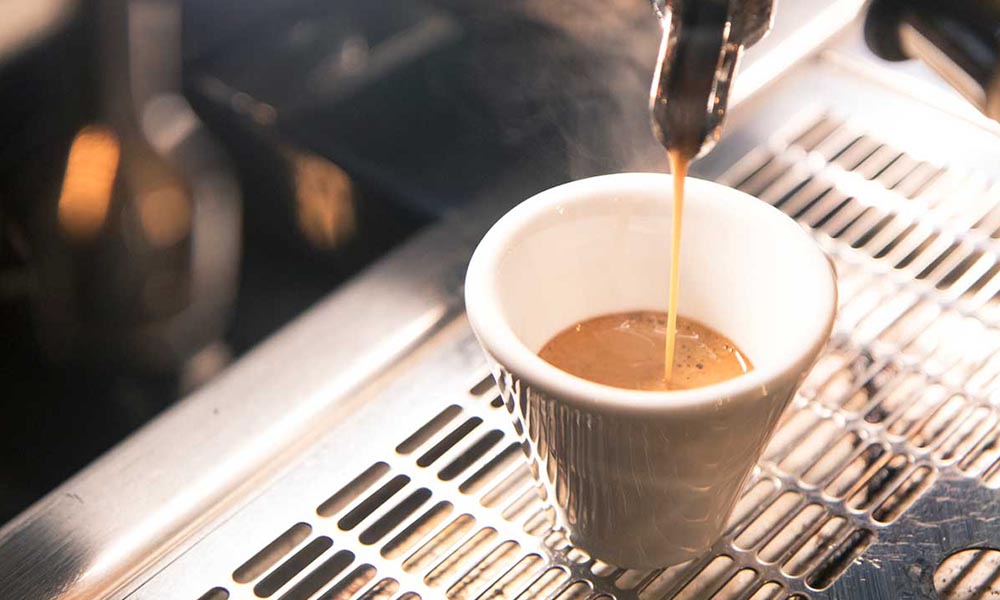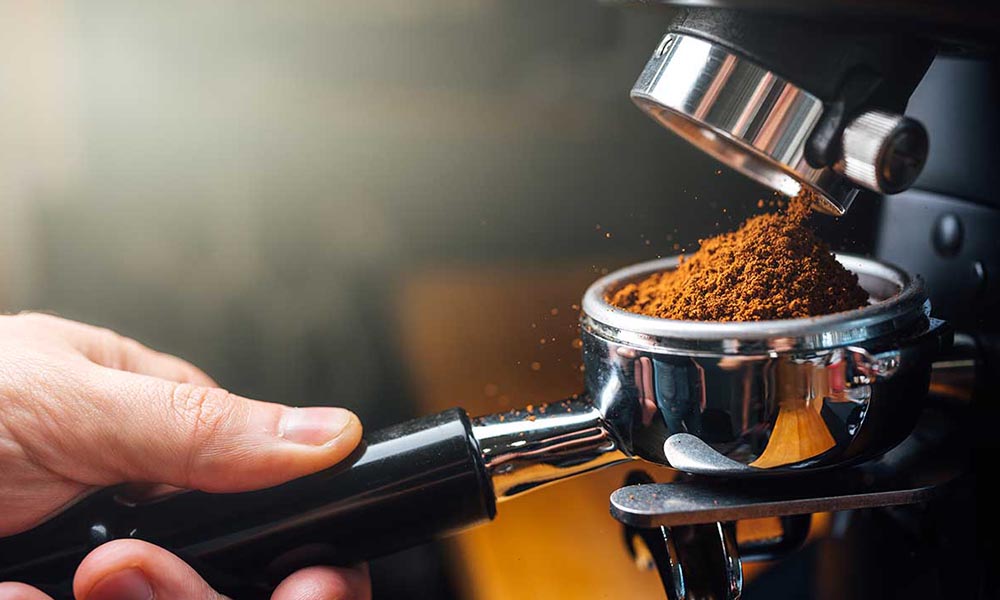
Decaf blend
70/30


One of the main reasons why people drink and love coffee is the caffeine it contains. Caffeine stimulates the central nervous system, which helps boost cognitive function, alertness and mood.
However, a large number of coffee lovers prefer to reduce their caffeine intake during the day. In response to this demand, the coffee industry has, over the decades, developed a range of decaffeination processes. But how exactly is coffee decaffeinated, and how does it differ from regular coffee?
Let’s start with a basic principle: caffeine does not contribute any positive organoleptic sensations, only a hint of bitterness. A decaffeinated coffee, if properly prepared, is indistinguishable from its caffeinated counterpart — except when directly compared or tasted by someone with a trained palate.
In this article, we’ll look at who invented decaffeinated coffee and the main processes that make it possible. Don’t worry — you won’t need to be a chemistry expert to understand how we manage to extract almost all of the caffeine (99.9%) from a coffee bean.
The first decaffeination process was developed 120 years ago by the German coffee merchant Ludwig Roselius. In 1903, he created the first commercial batch of decaffeinated coffee, selling it through his trading company Kaffee HAG — still a well-known name in the industrial coffee market today. Three years later, Roselius — together with Karl Wimmer and Johann Meyer — was granted a US patent for this coffee treatment.
Their decaffeination technique involved steaming the beans in brine and then dissolving the caffeine using benzene — a method now considered highly carcinogenic.
Since then, safer decaffeination methods have been developed for both food and health.

Since the early 1900s, several decaffeination methods have been developed to remove caffeine. Below, we’ll explore the most widely used ones.
Following in the footsteps of Ludwig Roselius, one of the main methods for removing caffeine from coffee involves the use of chemical solvents, mainly methylene chloride or ethyl acetate, in amounts deemed safe for human consumption.
A mixture of water and synthetic solvent (designed to closely mimic the chemical structure of caffeine-free coffee) is applied directly or indirectly to the green beans.
This is the process used for the decaffeinated coffee you’ll find on Caffèlab: it offers the classic aromas of Mokaflor arabica blends without caffeine and without leaving any chemical residues in the cup due to the decaffeination process. The coffee is dewaxed, gentle on your stomach, and suitable for restful sleep.
Since Roselius’ invention, one of the most common methods for removing caffeine has involved the use of chemical solvents such as methylene chloride or ethyl acetate. Both substances are used in safe, controlled quantities in line with international food safety regulations.
The process involves either directly or indirectly applying a mixture of water and solvent designed to selectively extract caffeine from green beans. The solvent is formulated to interact with the caffeine without altering the chemical structure of the coffee’s other aromatic compounds.
This is the exact method used to produce the decaffeinated coffee available on Caffèlab, a 100% arabica blend by Mokaflor, which preserves the typical aromas of our traditional blends, yet is free from caffeine and solvent residues in the cup.
Moreover, it is a dewaxed coffee, which makes it gentler on the stomach and perfect for evening consumption without disturbing your sleep.

The Swiss Water® process is one of the most highly regarded decaffeination methods in the world of quality coffee. First developed in Switzerland in the 1930s, it was refined and scaled for industrial use starting in the 1970s.
Unlike methods that use chemical solvents, the Swiss Water process relies solely on fresh water and a natural compound called Green Coffee Extract (GCE), which is essentially an extract of green coffee containing all the water-soluble compounds of coffee — except for caffeine.
The green coffee beans are immersed in this solution for up to ten hours. During this time, through the principle of osmosis, the caffeine migrates from the beans into the GCE. The caffeine is then removed from the solution using activated charcoal filters, without affecting the other aromatic compounds.
The result is a coffee that retains 99.9% of its original flavour profile, with a residual caffeine content of less than 0.01%.
For professionals in the specialty coffee industry, the Swiss Water method is perhaps the most well-known, as it is believed to preserve the intrinsic characteristics of the coffee. Moreover, it’s one of the safest and most natural ways to remove caffeine from green coffee.
From the highlands of Minas Gerais comes the brazilian swisswater specialty coffee, naturally decaffeinated using this very process, which gives it an unexpected body for a decaf.

Another highly interesting and natural method for removing caffeine from coffee involves the use of carbon dioxide. This technique, particularly appreciated in the world of quality coffee, makes use of CO₂ in a special state called supercritical, where it behaves both like a gas and a liquid.
The process takes place in specialised pressure chambers, where green coffee beans are immersed in liquid CO₂. Under extremely high pressure — up to 300 atmospheres — the CO₂ penetrates the beans and is able to selectively dissolve the caffeine, without altering the aromatic compounds that define coffee’s flavour profile.
Once the caffeine has been absorbed, the carbon dioxide is separated from the beans and treated: it can either be allowed to evaporate naturally or passed through a charcoal filter to capture the extracted caffeine. In either case, the result is a naturally decaffeinated coffee, with its original aromas almost completely preserved and no chemical solvents used.
Although more complex and expensive than other methods, this technique is often chosen to decaffeinate high-quality coffees because it guarantees a clean, aromatic result that respects the integrity of the raw material. It’s the perfect choice for anyone wanting to enjoy excellent coffee — even without caffeine — without sacrificing taste, body, or complexity.
For those who’d like to try a decaf made using this method, we recommend the Miscela Deca Naturale Chiaroscuro available on Caffelab.
Among the emerging trends in the world of decaffeination, growing attention is being paid to the method that uses a natural derivative of sugarcane: ethyl acetate. This substance, which also occurs naturally in some fruits, is used here as a gentle solvent to remove caffeine from green beans.
The process involves combining ethyl acetate with spring water. The beans are then exposed to moderate pressure and heat, which opens the cell structure and allows the caffeine to be selectively extracted. Once the extraction is complete, the beans are dried and returned to their original moisture level, ready for roasting.
What makes this method particularly interesting is its natural origin, combined with its ability to preserve the coffee’s flavour profile. Although the beans may appear slightly different in appearance from untreated coffee, in the cup the differences are minimal — almost unnoticeable. In taste tests of decafs produced with this method, acidity remains bright, flavour notes stay clear and complex, and the final result surprises with its balance and cleanliness.
This method is becoming increasingly popular in the specialty coffee world, as it offers a way to produce naturally decaffeinated coffee without synthetic solvents, while maintaining all the characteristics that make a cup of coffee special — even without the caffeine.